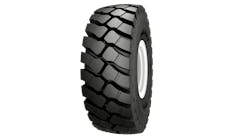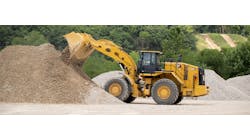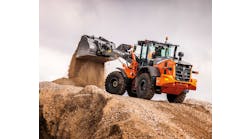Fuel efficiency is the name of the game in defining the new technology introduced recently by Volvo Construction Equipment at a large rock quarry near its Gothenburg, Sweden, headquarters. It was well worth traveling the miles from the West Coast of North America to drive the smooth Opti-Shift-equipped wheel loaders, to tour its Volvo Powertrain factory in Skövde, and to drive its articulated haulers.
With the OptiShift, which the Volvo staff says can reduce fuel consumption up to 15 percent, the wheel loaders are very easy to drive and maneuver, very smooth for the operator because of the ease of shifting from forward to reverse and back. It has a new torque converter with Lock Up and a free wheel stator, as well as Volvo's patented RBB (reverse by braking).
The benefits of OptiShift, Volvo's engineers say, include reverse fuel consumption in Load and Carry and transport applications; faster load cycles; increased operator comfort; better drive response; increased hill-climbing performance; smoother deceleration; and less loading stress on the driveline.
With OptiShift, the torque converter can provide up to two times the input torque from the engine. Power is hydraulically transferred from the pump rotor to the turbine rotor and on to the transmission. The engine powers the pump rotor that moves oil into the turbine rotor, thereby turning the turbine rotor. The stator acts as a stationary point for the oil, creating leverage. This effect reaches its maximum when the engine rotates the pump rotator without being able to initiate turbine rotor rotation.
The down side to a torque convertor, Volvo says, is that the utilization factor drops from the point where the turbine rotor reaches the same rotation speed as the pump rotor. By adding a drive clutch that mechanically locks the pump rotator and the turbine rotator, losses are eliminated. The OptiShift transmission shifts smoothly, with automatic lock-up in second, third and fourth gear. From within the cab, the operator can switch the lock-up function on or off from within the cab.
Volvo's new patented RBB is a braking feature that automatically assists machine deceleration by utilizing the standard service brake instead of the torque converter. Using the forward/reverse lever while decelerating, the RBB recognizes the speed, direction and throttle position and applies the service brake to slow the machine. It's a smooth deceleration and since the converter is not used, it saves fuel and reduces converter wear.
I toured Volvo's powertrain factory in Skövde, Sweden, where diesel engine production is divided into three main processes — casting, machining and assembly. Volvo Powertrain also has operations in France, Japan, North and South America. The factory began supplying engines to Volvo in 1927. Beginning as a local operation, the Skövde factory now manufactures engines for the entire global Volvo CE group.
I also had the opportunity to drive Volvo's 26.5-ton and 35-ton Volvo articulated haulers, which are impressively smooth in their steering, turning and downhill braking. There are seven sizes in the E-Series of haulers, equipped with V-ACT (Volvo Advanced Combustion Technology), Tier-3 Volvo engines that offer high torque at low revolutions to maintain fuel efficiency and reduce noise levels. The units also have fully automatic nine-speed fast-adaptive transmissions. Optimized gear-shifting pattern has a precise overlap of ratios to provide constant power transfer. The new models also have new frames, axles and a single-speed drop box with longitudinal differential and 100-percent lockup to reduce power losses and improve traction and fuel efficiency. The cooling systems have been improved to eliminate the need for additional supplemental cooling in hot climates.
Volvo CE has not lost sight of the role the operator plays in improving fuel efficiency and concern for the environment. With that in mind, it has launched “Eco Operator” a training program that gives operators practical and theoretical knowledge in improved machine operation and maneuvering as well as job planning. That includes knowing when to ease up on the accelerator and paying closer attention to correct tire pressure to reduce wear and lower fuel consumption. The program includes environmental training modules, simulator-based training and onsite follow-up with a trainer sitting with the operator in his own machine on a jobsite.
Major contractor Skanska enrolled its operators and a study of 37 of its operators found they reduced fuel consumption by 5 percent, representing savings of more than €250,000 (about U.S. $315,000) and a reduction in emissions of 500 tonnes of carbon dioxide. Some operators reduced consumption by 25 percent or more.





